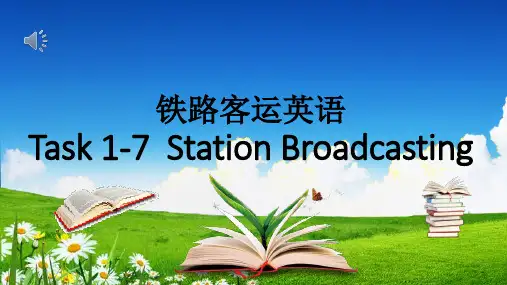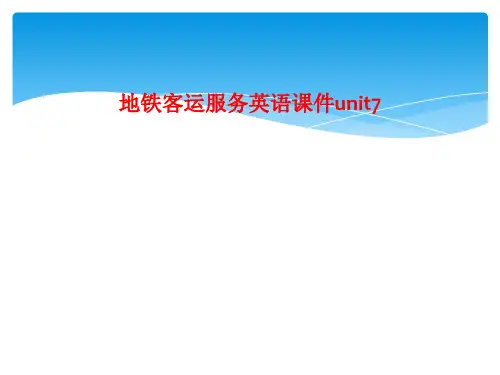城市轨道交通客运服务英语 unit 7 Subway Broadcasting
- 格式:ppt
- 大小:1.75 MB
- 文档页数:10

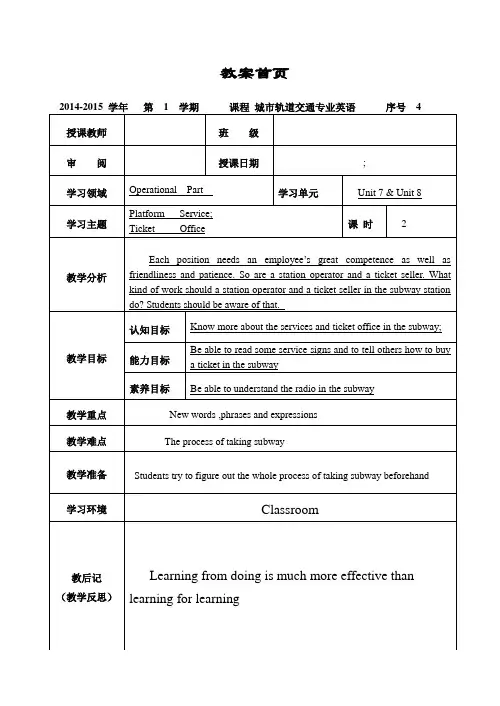
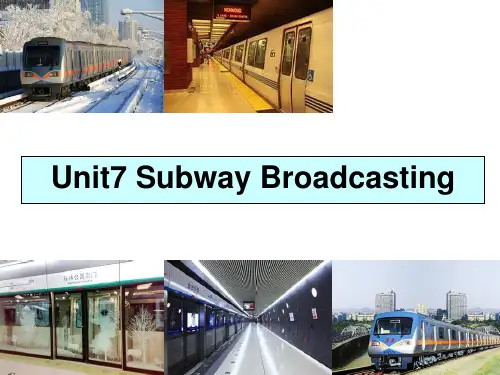
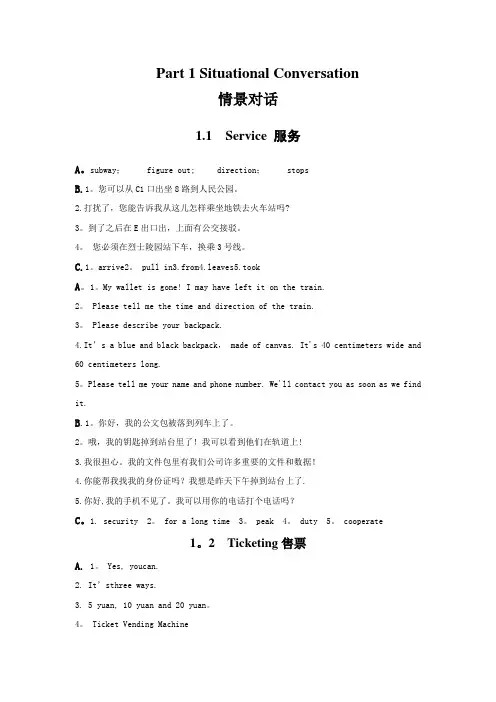
Part 1 Situational Conversation情景对话1.1 Service 服务A。
subway; figure out; direction; stopsB.1。
您可以从C1口出坐8路到人民公园。
2.打扰了,您能告诉我从这儿怎样乘坐地铁去火车站吗?3。
到了之后在E出口出,上面有公交接驳。
4。
您必须在烈士陵园站下车,换乘3号线。
C.1。
arrive2。
pull in3.from4.leaves5.tookA。
1。
My wallet is gone! I may have left it on the train.2。
Please tell me the time and direction of the train.3。
Please describe your backpack.4.It’s a blue and black backpack, made of canvas. It's 40 centimeters wide and 60 centimeters long.5。
Please tell me your name and phone number. We'll contact you as soon as we find it.B.1。
你好,我的公文包被落到列车上了。
2。
哦,我的钥匙掉到站台里了!我可以看到他们在轨道上!3.我很担心。
我的文件包里有我们公司许多重要的文件和数据!4.你能帮我找我的身份证吗?我想是昨天下午掉到站台上了.5.你好,我的手机不见了。
我可以用你的电话打个电话吗?C。
1. security 2。
for a long time 3。
peak 4。
duty 5。
cooperate1。
2 Ticketing售票A. 1。
Yes, youcan.2. It’sthree ways.3. 5 yuan, 10 yuan and 20 yuan。
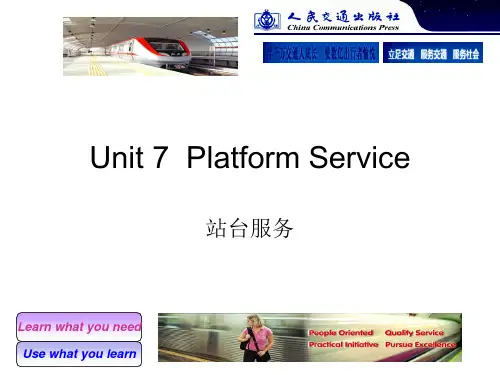


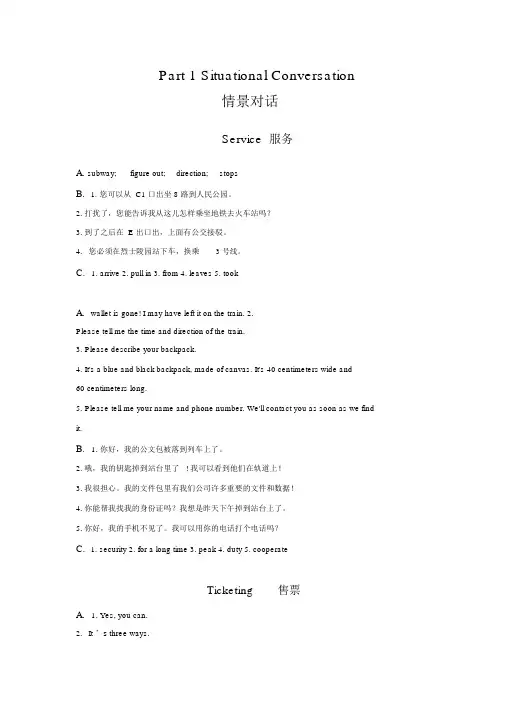
Part 1 Situational Conversation情景对话Service 服务A. subway;figure out; direction; stopsB. 1. 您可以从 C1 口出坐 8 路到人民公园。
2.打扰了,您能告诉我从这儿怎样乘坐地铁去火车站吗?3.到了之后在 E 出口出,上面有公交接驳。
4.您必须在烈士陵园站下车,换乘 3 号线。
C. 1. arrive 2. pull in 3. from 4. leaves 5. tookA.wallet is gone! I may have left it on the train. 2.Please tell me the time and direction of the train.3. Please describe your backpack.4. It's a blue and black backpack, made of canvas. It's 40 centimeters wide and60 centimeters long.5. Please tell me your name and phone number. We'll contact you as soon as we find it.B. 1. 你好,我的公文包被落到列车上了。
2.哦,我的钥匙掉到站台里了 ! 我可以看到他们在轨道上!3.我很担心。
我的文件包里有我们公司许多重要的文件和数据!4.你能帮我找我的身份证吗?我想是昨天下午掉到站台上了。
5.你好,我的手机不见了。
我可以用你的电话打个电话吗?C. 1. security 2. for a long time 3. peak 4. duty 5. cooperateTicketing售票A. 1. Yes, you can.2. It ’s three ways.3.5 yuan, 10 yuan and 20 yuan.4.Ticket Vending MachineB. 1. Tickets can be bought at Ticket Vending Machines of each station or usecity card.2. The chip in the card also allows you to buy tickets at ticket vending booth orin metro. Which is a time-saver if there are long lines at the ticket counter.3. Introduced the function of AFC system and the work principle of TVM.4. It's easy. Just go to the ticket office the subway.5. Related departments revealed that line 5 is completed, would change current ticketing system, achieve new ticketing system according to mileage.C.略A. 1. You can recharge your card at subway stations, convenience stores, banks oronline.2. Public transportation card can also be used to taxis and buses.3. Your card is not magnetic, we can give you a new card.4. Please fill in your name and phone number on the receipt.5. If the passengers need invoice, please go to customer service center to receive.B.略A. 1.我赶时间我想退票。
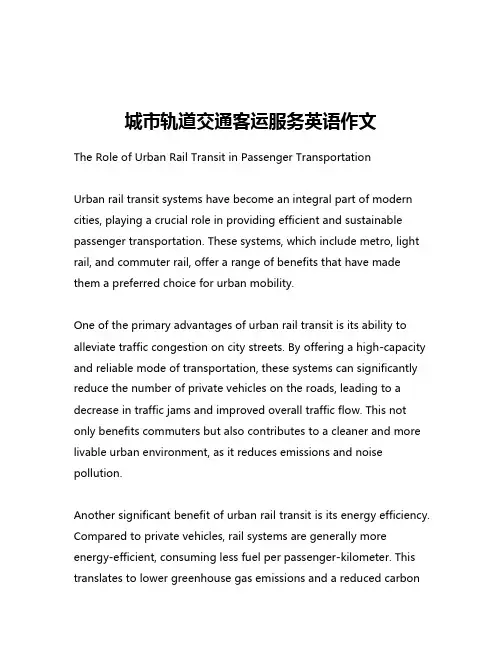
城市轨道交通客运服务英语作文The Role of Urban Rail Transit in Passenger TransportationUrban rail transit systems have become an integral part of modern cities, playing a crucial role in providing efficient and sustainable passenger transportation. These systems, which include metro, light rail, and commuter rail, offer a range of benefits that have made them a preferred choice for urban mobility.One of the primary advantages of urban rail transit is its ability to alleviate traffic congestion on city streets. By offering a high-capacity and reliable mode of transportation, these systems can significantly reduce the number of private vehicles on the roads, leading to a decrease in traffic jams and improved overall traffic flow. This not only benefits commuters but also contributes to a cleaner and more livable urban environment, as it reduces emissions and noise pollution.Another significant benefit of urban rail transit is its energy efficiency. Compared to private vehicles, rail systems are generally more energy-efficient, consuming less fuel per passenger-kilometer. This translates to lower greenhouse gas emissions and a reduced carbonfootprint, making them a more environmentally friendly option for urban transportation. Furthermore, the electrification of many rail systems allows for the integration of renewable energy sources, further enhancing their sustainability.Urban rail transit also plays a crucial role in promoting social equity and accessibility. By providing affordable and reliable transportation options, these systems enable individuals from diverse socioeconomic backgrounds to access employment, education, healthcare, and other essential services. This accessibility can help to bridge the gap between different neighborhoods and communities, fostering greater social inclusion and economic opportunities.Moreover, urban rail transit systems have the potential to shape urban development and land use patterns. By connecting different parts of a city, these systems can encourage transit-oriented development, where residential, commercial, and recreational areas are designed around transit hubs. This can lead to more compact and walkable communities, reducing the reliance on private vehicles and promoting a healthier and more sustainable urban lifestyle.In terms of passenger experience, urban rail transit offers a range of benefits. The systems typically provide a comfortable and efficient travel experience, with features such as air conditioning, Wi-Fi connectivity, and real-time information displays. This can contributeto increased passenger satisfaction and encourage the use of public transportation, further reducing the reliance on private vehicles.However, the implementation and operation of urban rail transit systems are not without challenges. The high capital costs associated with the construction and maintenance of these systems can be a significant barrier, particularly for smaller or developing cities. Additionally, the integration of urban rail transit with other modes of transportation, such as buses and bike-sharing schemes, can be complex and require careful planning and coordination.Despite these challenges, the benefits of urban rail transit in passenger transportation are widely recognized, and many cities around the world are investing in the development and expansion of these systems. As urban populations continue to grow and the demand for sustainable transportation solutions increases, the role of urban rail transit in shaping the future of urban mobility will only become more crucial.。
